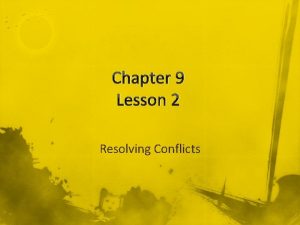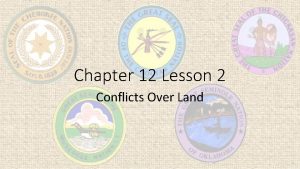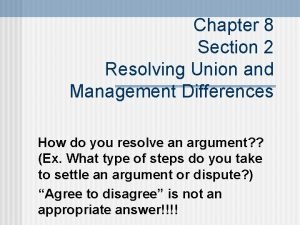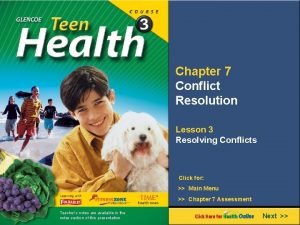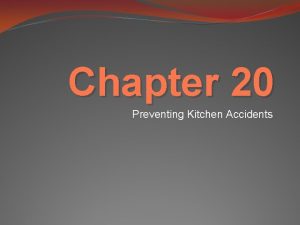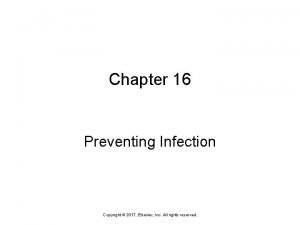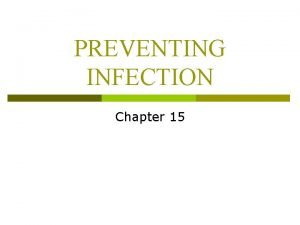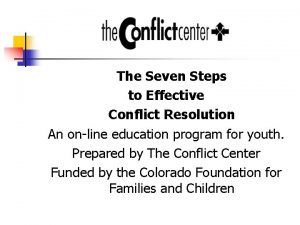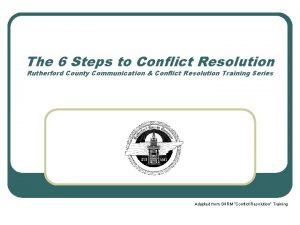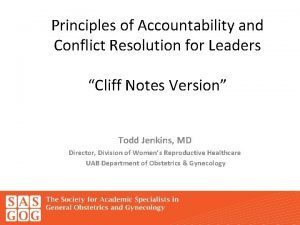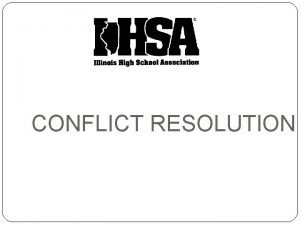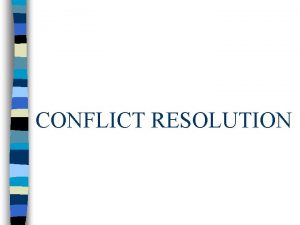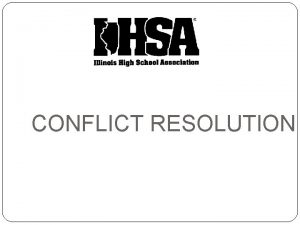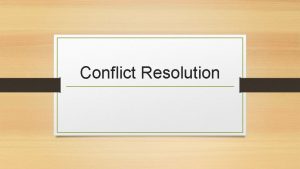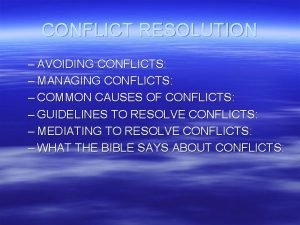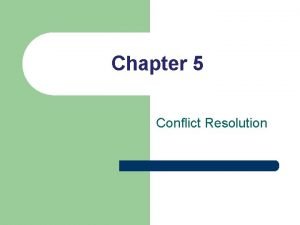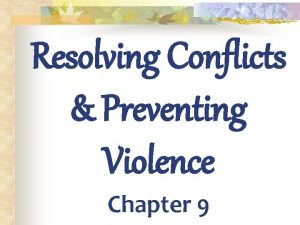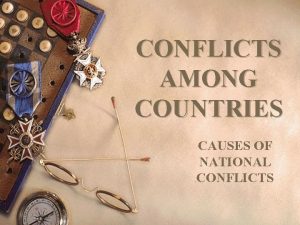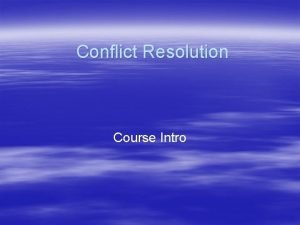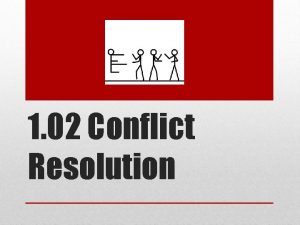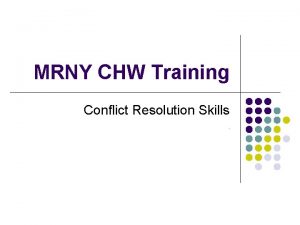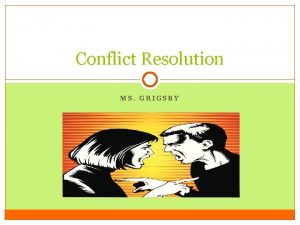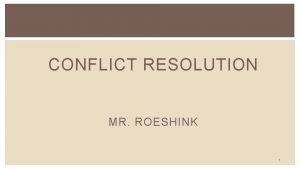Chapter 7 Conflict Resolution Lesson 2 Preventing Conflicts




















- Slides: 20

Chapter 7 Conflict Resolution Lesson 2 Preventing Conflicts Click for: >> Main Menu >> Chapter 7 Assessment Teacher’s notes are available in the notes section of this presentation. Next >>

§ escalate Become more serious § revenge Punishment, injury, or insult to the person seen as the cause of the strong emotion § mob mentality Acting or behaving in a certain and often negative manner because others are doing it

In this lesson, you will learn to § identify factors that build conflicts. § prevent conflicts from becoming serious. § develop stress management techniques to release anger.

Classifying Why Conflicts Build Using the diagram to the right as a guide, create a concept map that shows why conflicts build. Anger

Why Conflicts Build Factors that can cause a conflict to escalate include anger, jealousy, group pressure, and the use of alcohol and drugs. escalate Become more serious

Why Conflicts Build ! The Warning Signs of Conflict Physical Signs Emotional Signs A knot in the stomach Feeling concerned Faster heart rate Getting defensive A lump in the throat Wanting to cry Balled-up fists Not feeling valued Cold or sweaty palms Wanting to lash out A sudden surge of energy Wanting to escape !

Citizenship When a fight is developing, you can show good citizenship by encouraging those involved to find a positive way to resolve the conflict. However, if the fight turns violent, do not get involved. Instead, get help from a trusted adult right away.

Anger itself is not a problem—the challenge is how to deal with the anger in an appropriate way.

Anger Step away Be quiet for a while Dealing with Anger Share your feelings Focus on the problem not the person Identify the problem Focus on something else

Jealousy is a gateway emotion. Jealousy Anger Resentment

Jealousy Revenge is often seen as “payback” or an opportunity to “even the score. ” revenge Punishment, injury, or insult to the person seen as the cause of the strong emotion Revenge turns a minor conflict into a major conflict.

Group Pressure People in the middle of a public conflict often get swept up in a mob mentality Acting or behaving in a certain and often negative manner because others are doing it If you find yourself in this kind of situation, get help from a trusted adult right away.

Alcohol and Drugs Violent crimes committed under the influence of alcohol are a leading cause of teen deaths. The use of alcohol and other drugs makes it difficult to resolve conflicts in a peaceful way.

Preventing Conflicts from Building Show respect for yourself and for others. Learn to understand your feelings. Keep your conflicts private. Avoid using alcohol or other drugs. Preventing Conflicts from Building Learn to accept people who are different from you. Put yourself in the other person’s situation.

Lesson 2 Review What I Learned Vocabulary What is mob mentality?

Lesson 2 Review What I Learned Recall Name two factors that fuel conflicts.

Lesson 2 Review What I Learned List Name two ways to prevent conflicts from building.

Lesson 2 Review Thinking Critically Evaluate Andy and his best friend Jake tried out for the concert band. Jake made it, but Andy did not. Now Andy cannot bring himself to congratulate Jake, but he is not sure why. Tell what Andy may be feeling and what he can do about it.

Lesson 2 Review Thinking Critically Synthesize Jill was on her way home when Connie stopped her outside the school. Connie began to raise her voice, telling Jill that she had done something to upset her. What strategies should Jill take to resolve the conflict in a positive way? Why are these strategies important?

End of Chapter 7 Conflict Resolution Lesson 2 Preventing Conflicts Click for: >> Main Menu >> Chapter 7 Assessment
 Chapter 9 lesson 2 resolving conflicts
Chapter 9 lesson 2 resolving conflicts Chapter 9 resolving conflicts and preventing violence
Chapter 9 resolving conflicts and preventing violence Chapter 24 lesson 2 preventing and treating stds
Chapter 24 lesson 2 preventing and treating stds What is conflict and conflict resolution?
What is conflict and conflict resolution? Chapter 9 lesson 2 resolving conflicts
Chapter 9 lesson 2 resolving conflicts Brainpop seminole wars
Brainpop seminole wars Chapter 9 lesson 2 resolving conflicts answer key
Chapter 9 lesson 2 resolving conflicts answer key Chapter 7 conflict resolution answer key
Chapter 7 conflict resolution answer key Chapter 20 preventing kitchen accidents
Chapter 20 preventing kitchen accidents Chapter 16 preventing infection
Chapter 16 preventing infection Chapter 14:2 preventing accidents and injuries
Chapter 14:2 preventing accidents and injuries Chapter 13:2 preventing accidents and injuries
Chapter 13:2 preventing accidents and injuries Chapter 4 preventing injuries through fitness
Chapter 4 preventing injuries through fitness Chapter 15 preventing infection
Chapter 15 preventing infection High resolution low resolution
High resolution low resolution Cudsa model
Cudsa model Teamwork in work immersion
Teamwork in work immersion What are the 7 steps in conflict resolution?
What are the 7 steps in conflict resolution? 6 step conflict resolution
6 step conflict resolution What is conflict resolution in customer service
What is conflict resolution in customer service Accountability in conflict resolution
Accountability in conflict resolution




